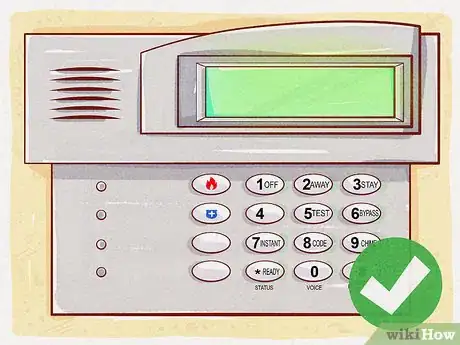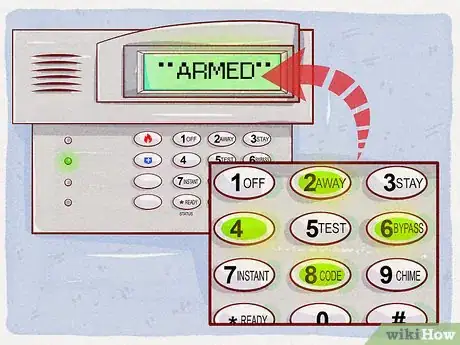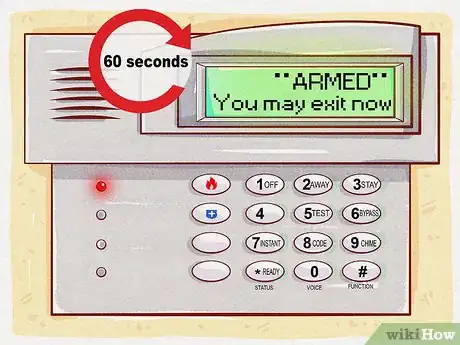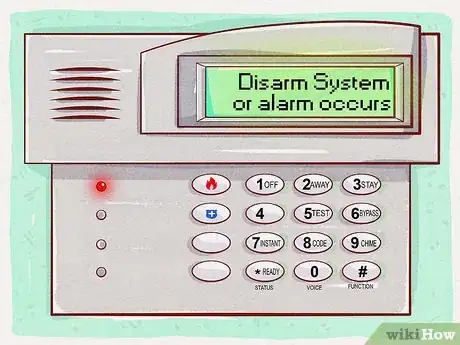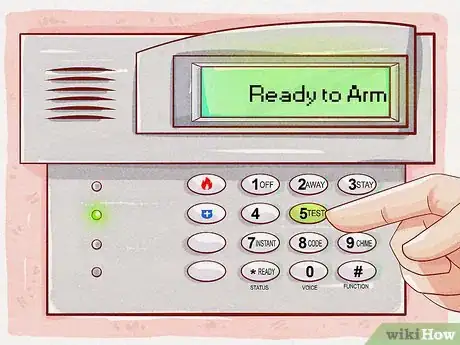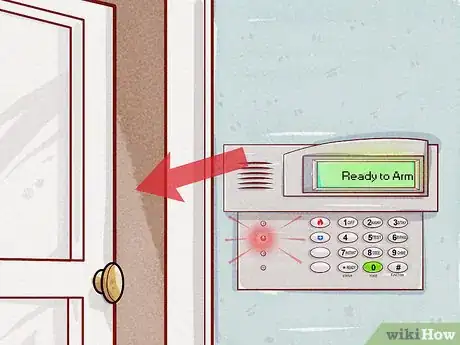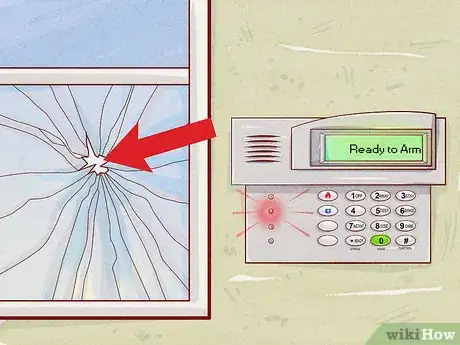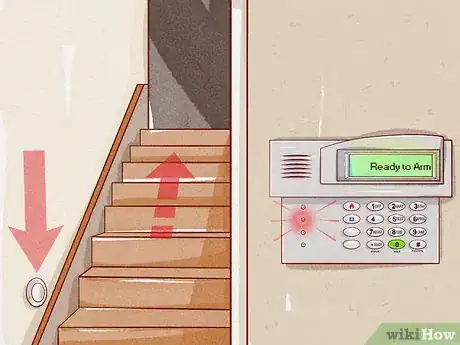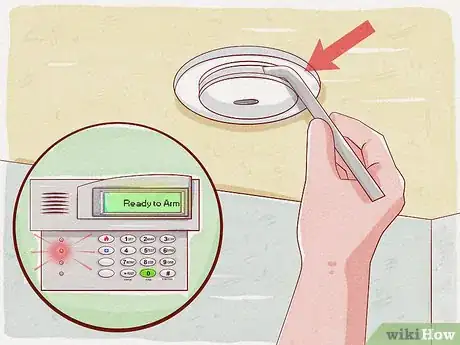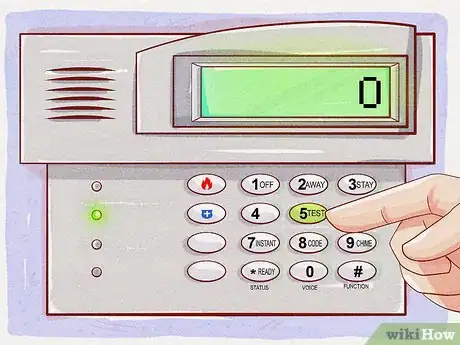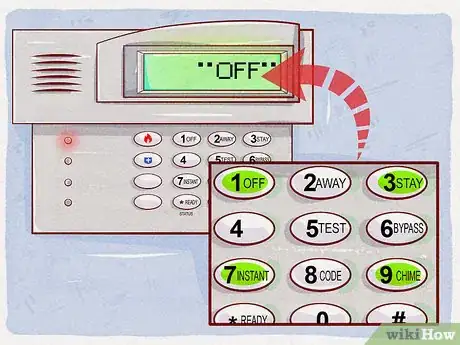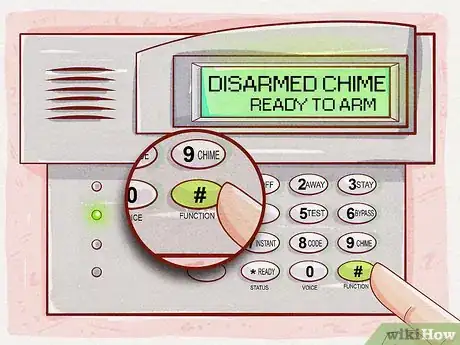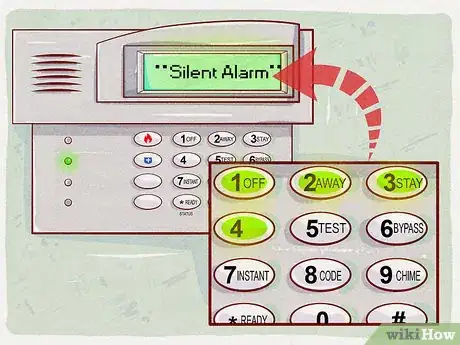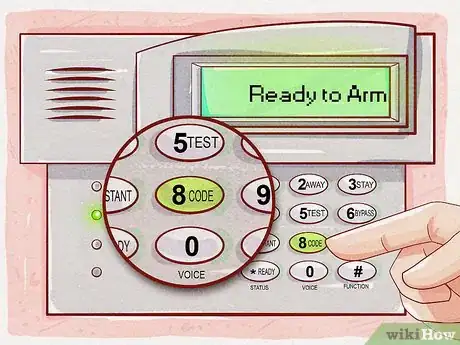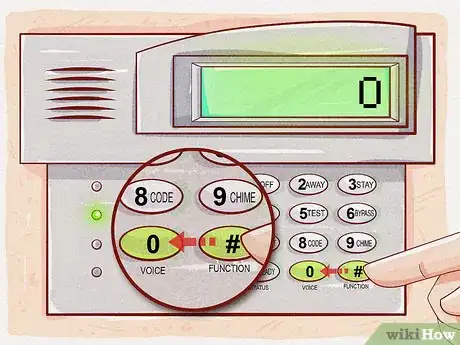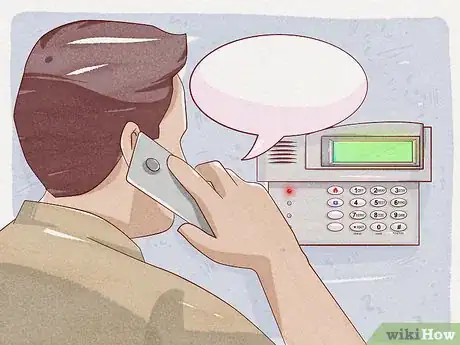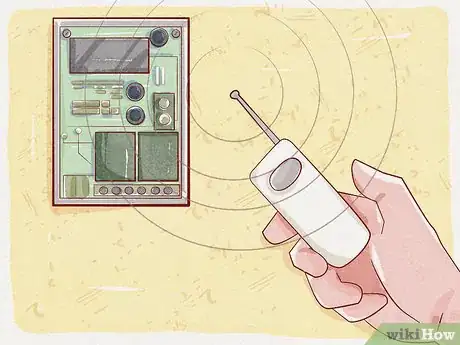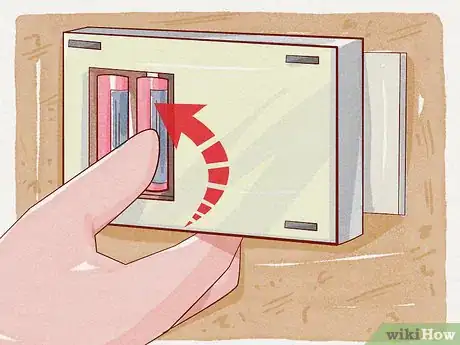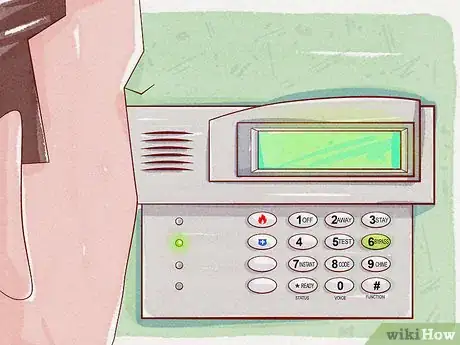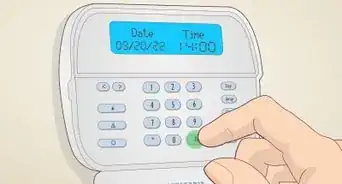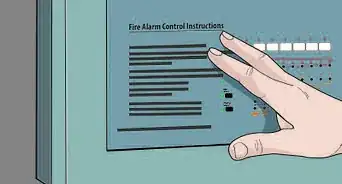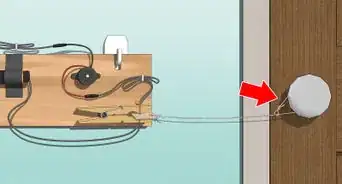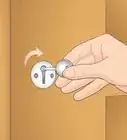X
wikiHow is a “wiki,” similar to Wikipedia, which means that many of our articles are co-written by multiple authors. To create this article, 14 people, some anonymous, worked to edit and improve it over time.
This article has been viewed 30,152 times.
Learn more...
A security alarm is an alarm system that detects intrusion or burglaries in a residential (such as a house or apartment) or commercial (such as a store or office) building. It is used to commonly deter intrusion, break-ins, vandalism, and much more. Here are some common directions on how to use a security system manufactured by Honeywell, including ADT.[1]
Steps
Part 1
Part 1 of 7:
Arming/Disarming a Security System
-
1Check the ready light is it green. If the LED is not green, you cannot arm the system. Check for any open sensors listed on the display.
- If a motion detector is tripped, the LED will not turn green, but you will still be able to arm the system STAY.
-
2Enter your four-digit PIN on the keypad. Then press the following keys depending on what you are doing:
- OFF: Disarms the security system, and clears any previous alarms or faults. The keypad beeps once.
- AWAY: Arms the security system in "away" mode. This enables all sensors, including motion detectors, doors, windows, and glass break detectors. The security panel repeatedly beeps until the exit delay (time you have to leave the premises) ends, and beeps rapidly within the last 10 seconds. The delay resets if an exit door is opened within the last ten seconds of exit delay.
- STAY: Arms the security system in "stay" mode. This enables all sensors except for motion detectors. The security system beeps three times.
- NIGHT-STAY: Arms all perimeter sensors, plus a few motion detectors. To do so, press the stay button twice after entering your security code. The motion detectors armed in NIGHT-STAY is programmed by your security installer.
- INSTANT: Arms the security system in "stay" mode, but removes the entry delay. The entry delay is the grace period before the alarm sounds. The entry delay is set by the installer of the security system. The security system beeps three times.
- MAX: Arms the security system in "away" mode, but removes the entry delay. If the security system is not disarmed before entering the home, the alarm will sound.
Advertisement -
3Leave the premises within the exit delay. This is the usual time that is set by the installer, which allows for normal exit through main doors.
- An alarm sounds immediately if a door not normally used for exit, or if any enabled sensor is tripped. If the keypad is equipped with a loud sounder, then that will be used to sound the alarm. If the keypad is not equipped, then any external sounders, along with alternating high and low-frequency continuous beeps will sound.
-
4Turn off the system upon return. Do this by entering your PIN and pressing OFF. After the entry delay ends, the alarm will sound.
- During the entry delay, the keypad will beep continuously until the delay ends. During the last ten seconds, the keypad will beep rapidly.
- If a false alarm sounds, enter your four-digit PIN then press OFF within two minutes to avoid the monitoring center being notified. To clear the false alarm, enter your four-digit PIN again then press OFF.
Advertisement
Part 2
Part 2 of 7:
Testing Your Security System
-
1Enter your four-digit PIN then press TEST. Then press [0]. The alarm will sound for a few seconds, then the display will read "Test" or "Test in Progress".
-
2Open a door or window to test it. You should hear three beeps, followed by the name of the zone (if your security system is voice equipped).
-
3Bang near a glass break detector to test it. You should hear three beeps, followed by the name of the zone.
-
4Walk by a motion detector to test it. You should hear three beeps, followed by the name of the zone.
-
5Test a smoke detector by inserting an Allen key into the "Test" hole of the smoke detector. This will sound the fire alarm without notifying the fire department.
-
6Test all other security functions by calling your security company.
-
7Deactivate test mode by entering your four digit PIN and pressing OFF, or by calling your security company. Should you forget to deactivate test mode, test mode will deactivate automatically after four hours.
Advertisement
Part 3
Part 3 of 7:
Bypassing a Security Zone
-
1Enter your four-digit PIN, followed by BYPASS, followed by the two digit code for zone to be bypassed. The keypad should beep once.
- Bypassing a zone disables it while armed. If a bypassed zone is tripped, the alarm system will simply ignore it. You have to bypass the zone every time you want to arm the security system, as bypassed zones are reset upon disarming the security system.
-
2Bypass all zones. Enter in your four-digit PIN, followed by BYPASS, followed by the "#" key. The keypad should beep for every bypassed zone.
Advertisement
Part 4
Part 4 of 7:
Sounding an Alarm Manually
-
1Hold down the appropriate letter key. Alternatively, press the specific two buttons.
- To sound a fire alarm, press the button with a pictogram of a fire for two seconds. Alternatively, press the two buttons with arrows from the fire symbol.
- To sound a security alarm, press the button with a pictogram of a police shield for two seconds. Alternatively, press the two buttons with arrows from the police symbol, or press the panic button on the keychain remote.
- To sound a medical alarm, use a medical pendant you are wearing or press the HELP button on the medical intercom. Alternatively, press the button with a pictogram of a medical cross for two seconds, or press the two buttons with arrows from the medical button.
-
2Enter your four-digit duress PIN in an emergency "duress" situation. If forced to disarm your security system, enter this four-digit code onto the security panel and press OFF. The system will act normally, but the police will be notified Immediately.
- There will be no notification (phone call or text message) that the dispatch center has received the alarm. The police may take up to 5 minutes to arrive. Make sure that everyone knows this PIN, and make sure that it is only used in an emergency.
Advertisement
Part 5
Part 5 of 7:
Changing, Adding or Removing a Security Code
-
1Enter your four-digit security code. Next press CODE, then the user number. The defaults are follows:
- 01 is reserved for the installer code.
- 02 is reserved for the master code.
- 03/33 is reserved for the partition code.
-
2Follow the appropriate step:
- To add/change a user code, enter their code. The security system beeps once.
- To delete a user code, press # then 0.
- To change the permissions of that code, press # then 1 then any of the following: 0 is arm only. 1 is guest. 2 is duress code. 3 is master code.
Advertisement
Part 6
Part 6 of 7:
Clearing a False Alarm Signal
-
1Call the toll free number for your security company. The toll free number is usually written on any yard signs or on your security panel.
-
2Explain what happened. Say your passphrase. This is required to cancel your alarm. If you do not say it, then the police will be dispatched to your home.
-
3Be polite. Being rude will just aggravate the situation.
Advertisement
Part 7
Part 7 of 7:
Troubleshooting
-
1Check to see if the sensor is within range of the RF receiver and charged (if the sensor is wireless) or if the wires to the sensor are not cut (if the sensor is wired).
-
2Check that the security system is receiving power. If your security system is displaying "NO AC" or "AC LOSS" on the screen, then make sure that there is no blackout in the area and that the outlet for the security system is receiving power. If your security system is displaying "LO BAT", then replace the battery on the security system (if no zones are displayed) or any zones displayed. The security system requires a lead-acid battery, and the sensors require alkaline batteries.
-
3Call the toll free number for your security company. The toll free number is usually written on any yard signs or on your security panel.
-
4Bypass any faulty zones. Until the security company provides you with the necessary resources to service your alarm, bypass them.
- When a service person does come to service your security system, check their credentials. You do not want them to break your security system even further.[2]
Advertisement
Community Q&A
-
QuestionWhat does an 05 fault mean?
 AasimTop AnswererThis means that zone 05 is either open or is having trouble. Check that the sensor for zone 5 is intact, and that the door is closed. If you are still getting a fault on the security panel, call your security company.
AasimTop AnswererThis means that zone 05 is either open or is having trouble. Check that the sensor for zone 5 is intact, and that the door is closed. If you are still getting a fault on the security panel, call your security company. -
QuestionHow do I change the volume of the keypad?
 AasimTop AnswererYou can only change the volume of the voice on the keypad. To do so, press #, then press "0", then press 3 to raise the volume or 6 to lower the volume. Repeat this process to adjust the volume.
AasimTop AnswererYou can only change the volume of the voice on the keypad. To do so, press #, then press "0", then press 3 to raise the volume or 6 to lower the volume. Repeat this process to adjust the volume. -
QuestionHow to reset the system when moving into a new home?
 AasimTop AnswererDon't worry about resetting the alarm for the next user. When the next user wants to activate the security system they can call the security company anytime to activate it.
AasimTop AnswererDon't worry about resetting the alarm for the next user. When the next user wants to activate the security system they can call the security company anytime to activate it.
Advertisement
Warnings
- Do not enter if an alarm is sounding. Instead, call your local emergency services. If the security system is monitored, police will be on their way.⧼thumbs_response⧽
- Always put your security system on test prior to servicing; failure to do so may trigger a tamper alarm and dispatch police.⧼thumbs_response⧽
- If upon entering you hear rapid beeping from the keypad, this indicates that an alarm previously sounded. Leave the premises immediately; the intruder can be still on site potentially armed and dangerous. Call your emergency services or wait for help to arrive.⧼thumbs_response⧽
- You are responsible for any fines incurred for false alarms by either your security company or law enforcement.⧼thumbs_response⧽
- Security alarms can be extremely loud. For your hearing protection, only install loud external sounders outside where neighbors can easily be notified, and install slightly quieter external sounders inside. Consider using a bell as an internal sounder; it is usually quieter, yet still alarming.⧼thumbs_response⧽
Advertisement
References
About This Article
Advertisement
